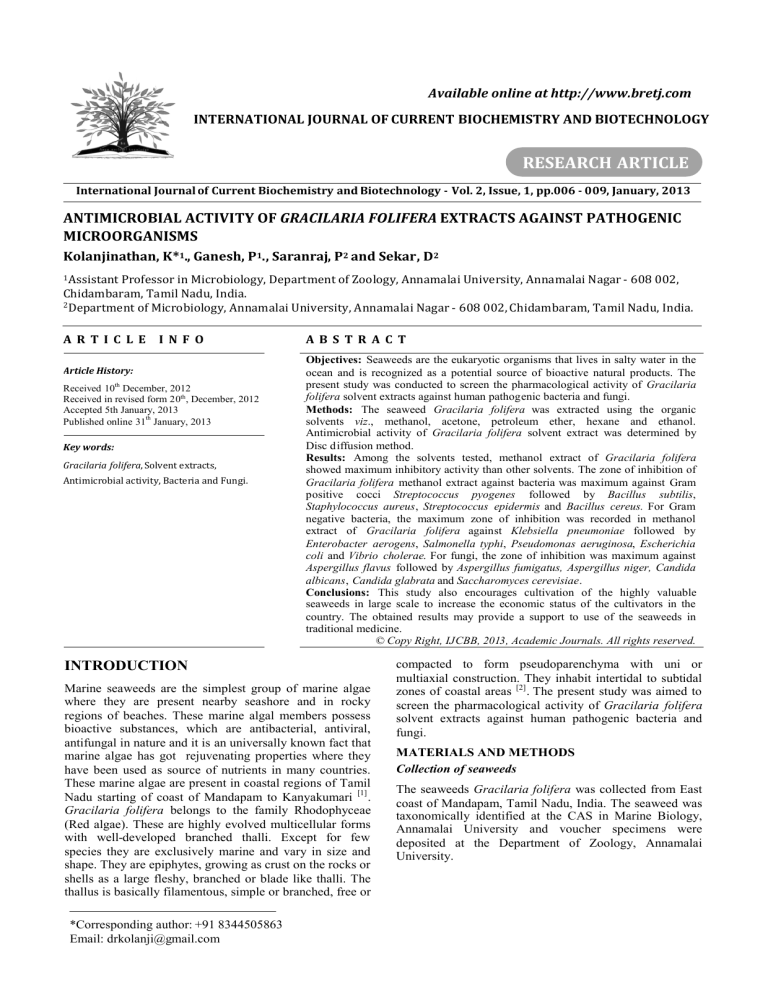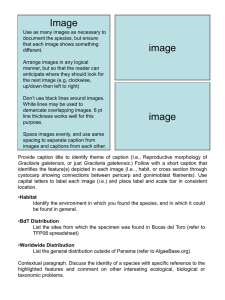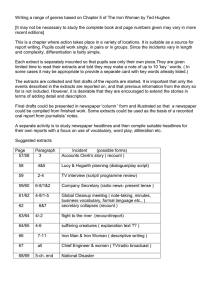
Available online at http://www.bretj.com
INTERNATIONAL JOURNAL OF CURRENT BIOCHEMISTRY AND BIOTECHNOLOGY
RESEARCH ARTICLE
International Journal of Current Biochemistry and Biotechnology - Vol. 2, Issue, 1, pp.006 - 009, January, 2013
ANTIMICROBIAL ACTIVITY OF GRACILARIA FOLIFERA EXTRACTS AGAINST PATHOGENIC
MICROORGANISMS
Kolanjinathan, K*1., Ganesh, P1., Saranraj, P2 and Sekar, D2
1 Assistant
Professor in Microbiology, Department of Zoology, Annamalai University, Annamalai Nagar - 608 002,
Chidambaram, Tamil Nadu, India.
2 Department of Microbiology, Annamalai University, Annamalai Nagar - 608 002, Chidambaram, Tamil Nadu, India.
AR TIC L E
I NF O
Article History:
Received 10th December, 2012
Received in revised form 20th, December, 2012
Accepted 5th January, 2013
Published online 31th January, 2013
Key words:
Gracilaria folifera, Solvent extracts,
Antimicrobial activity, Bacteria and Fungi.
ABS TR AC T
Objectives: Seaweeds are the eukaryotic organisms that lives in salty water in the
ocean and is recognized as a potential source of bioactive natural products. The
present study was conducted to screen the pharmacological activity of Gracilaria
folifera solvent extracts against human pathogenic bacteria and fungi.
Methods: The seaweed Gracilaria folifera was extracted using the organic
solvents viz., methanol, acetone, petroleum ether, hexane and ethanol.
Antimicrobial activity of Gracilaria folifera solvent extract was determined by
Disc diffusion method.
Results: Among the solvents tested, methanol extract of Gracilaria folifera
showed maximum inhibitory activity than other solvents. The zone of inhibition of
Gracilaria folifera methanol extract against bacteria was maximum against Gram
positive cocci Streptococcus pyogenes followed by Bacillus subtilis,
Staphylococcus aureus, Streptococcus epidermis and Bacillus cereus. For Gram
negative bacteria, the maximum zone of inhibition was recorded in methanol
extract of Gracilaria folifera against Klebsiella pneumoniae followed by
Enterobacter aerogens, Salmonella typhi, Pseudomonas aeruginosa, Escherichia
coli and Vibrio cholerae. For fungi, the zone of inhibition was maximum against
Aspergillus flavus followed by Aspergillus fumigatus, Aspergillus niger, Candida
albicans, Candida glabrata and Saccharomyces cerevisiae.
Conclusions: This study also encourages cultivation of the highly valuable
seaweeds in large scale to increase the economic status of the cultivators in the
country. The obtained results may provide a support to use of the seaweeds in
traditional medicine.
© Copy Right, IJCBB, 2013, Academic Journals. All rights reserved.
INTRODUCTION
Marine seaweeds are the simplest group of marine algae
where they are present nearby seashore and in rocky
regions of beaches. These marine algal members possess
bioactive substances, which are antibacterial, antiviral,
antifungal in nature and it is an universally known fact that
marine algae has got rejuvenating properties where they
have been used as source of nutrients in many countries.
These marine algae are present in coastal regions of Tamil
[1]
Nadu starting of coast of Mandapam to Kanyakumari .
Gracilaria folifera belongs to the family Rhodophyceae
(Red algae). These are highly evolved multicellular forms
with well-developed branched thalli. Except for few
species they are exclusively marine and vary in size and
shape. They are epiphytes, growing as crust on the rocks or
shells as a large fleshy, branched or blade like thalli. The
thallus is basically filamentous, simple or branched, free or
*Corresponding author: +91 8344505863
Email: drkolanji@gmail.com
compacted to form pseudoparenchyma with uni or
multiaxial construction. They inhabit intertidal to subtidal
zones of coastal areas [2] . The present study was aimed to
screen the pharmacological activity of Gracilaria folifera
solvent extracts against human pathogenic bacteria and
fungi.
MATERIALS AND METHODS
Collection of seaweeds
The seaweeds Gracilaria folifera was collected from East
coast of Mandapam, Tamil Nadu, India. The seaweed was
taxonomically identified at the CAS in Marine Biology,
Annamalai University and voucher specimens were
deposited at the Department of Zoology, Annamalai
University.
International Journal of Current Biochemistry and Biotechnology - Vol. 2, Issue, 1, pp.006-009, January, 2013
Preparation of seaweed extracts
The collected Gracilaria folifera was cleaned and necrotic
parts were removed. The seaweed was washed with tap
water to remove any associated debris and shade dried at
room temperature (28±2oC) for 5-8 days or until they are
brittle easily by hand. After completely drying, the
seaweed material (1.0 kg) was ground to a fine powder
using Electrical blender. 40 g of powdered sea weeds were
extracted successively with 200 ml of solvents (Methanol,
Acetone, Petroleum ether, Hexane and Ethanol) in
Soxhelet extractor until the extract was clear. The extracts
were evaporated to dryness reduced pressure using rotary
vacuum evaporator and the resulting pasty form extracts
were stored in a refrigerator at 4
C for future use.
Disc preparation
Disc of 5 mm diameter were pretreated using Whattman
filter paper No.1. These were sterilized in the hot air oven
at 160
C for 1 hour. The solvent extracts of Gracilaria
folifera (Methanol, Acetone, Petroleum ether, Hexane and
Ethanol) were mixed with 1ml of Dimethyl sulfoxide
(DMSO). The discs were impregnated with 20l of
different solvent extracts of sea weeds at two different
concentrations ranging 2.5mg/ml and 5mg/ml to check
their antibacterial activity and antifungal activity. The
paper discs which contain 5% DMSO were act as a blind
control and the paper discs containing Ampicillin
(5mg/disc) act as a positive control for bacteria and the
paper discs containing Flucanozole (100 units/disc) act as
a positive control for fungi.
Collection of test microbial cultures
Eleven different bacterial cultures were obtained from
RMMC Hospital, Annamalai University, Chidambaram.
Staphylococcus
aureus,
Streptococcus
epidermis,
Streptococcus pyogenes, Bacillus subtilis, Bacillus cereus,
Escherichia coli, Pseudomonas aeruginosa, Vibrio
cholerae, Salmonella typhi, Klebsiella pneumonia and
Enterobacter aerogens. Six different fungal isolates were
used in this present study. The fungal cultures were
procured from RMMC Hospital, Annamalai University,
Chidambaram. Aspergillus flavus, Aspergillus niger,
Aspergillus fumigatus, Saccharomyces cerevisiae, Candida
albicans and Candida glabrata.
Determination of Antimicrobial activity of Gracilaria
folifera
The antibacterial and antifungal activity of Gracilaria
folifera extract was determined by Disc diffusion method
[3]
proposed by Bauer et al. . A bacterial and fungal
suspension was spread on Mueller-Hinton (pH 7.4) agar
using a cotton swab. The Mueller Hinton agar plates were
prepared and inoculated with test bacterial and fungal
organisms by spreading the bacterial and fungal inoculum
on the surface of the media. To study the antibacterial
activity, the discs containing Gracilaria folifera extracts
(Methanol, Acetone, Petroleum ether, Hexane and
Ethanol) at two different concentration (2.5mg/ml and
5mg/ml) was placed on the surface of the Mueller Hinton
agar plates. For the analysis of antifungal activity, the
discs containing Gracilaria folifera extracts at 10 mg/ml
was placed on the surface of the Mueller Hinton agar
plates. The paper discs which contain 5% DMSO were act
as a blind control, the paper discs containing Ampicillin
(5mg/disc) act as a positive control for bacteria and the
paper discs containing Flucanozole (100 units/disc) act as
a positive control for fungi . The bacterial plates were
incubated at 37
C for 24 hours. The fungal plates were
incubated at 28
C for 2 days (yeasts) and 3 days (moulds).
The antibacterial and antifungal activity was assessed by
measuring the diameter of the zone of inhibition (in mm).
Each assay in these experiments was repeated three times
for concordance.
RESULTS AND DISCUSSION
Seaweeds are the eukaryotic organisms that lives in salty
water in the ocean and is recognized as a potential source
of bioactive natural products [4]. They contain compounds
ranging from sterols, terpenoids to brominated phenolic,
which shows bioactive against microorganisms [5]. In the
present study, antibacterial activity of five different
solvents viz., methanol, acetone, Petroleum ether, hexane
and ethanol extracts of Gracilaria folifera was evaluated
against pathogenic bacteria. Among five solvent extracts
tested, the methanol extract showed the greatest inhibition
diameters against Gram positive and Gram negative
bacterial isolates. These results are in agreement with the
observations of Vlachos et al. [6], Gonzalez et al. [7] ,
[8]
Ozdemir et al. (2004) , Karabay-Yavasoglu et al.
[9]
(2007) , Taskin et al. (2007) [10] and Kandhasamy and
[11]
Arunachalam (2008) , who reported that extracts
prepared with methanol showed the best activity. The
results from the present study showed that the Gram
positive bacteria are more susceptible than Gram negative
bacteria on seaweeds extracts which was also supported
from earlier works with different species of seaweeds
indicating that the more susceptibility of Gram-positive
bacteria to the algal extracts was due to the differences in
their cell wall structure and their composition
(Kandhasamy and Arunachalam, 2008)[11].
The methanol extract of Gracilaria folifera (5.0mg/ml)
showed highest mean zone of inhibition (18±0.4mm)
against the Gram positive cocci Streptococcus pyogenes
followed by Bacillus subtilis (17±0.5mm), Staphylococcus
aureus (17±0.3mm), Streptococcus epidermis (16±0.6mm)
and Bacillus cereus (16±0.2mm) . For Gram a negative
bacterium, the maximum zone of inhibition was recorded
in methanol extract of Gracilaria folifera against
Klebsiella pneumoniae (17±0.5mm) followed by
Enterobacter aerogens (17±0.3mm), Salmonella typhi
(16±0.6mm), Pseudomonas aeruginosa (16±0.5mm),
Escherichia coli (16±0.3mm) and Vibrio cholerae
(11±0.4mm). The zone of inhibition obtained from the
Hexane extract of seaweed Gracilaria folifera against
bacterial pathogens was comparatively very less when
compared to the other solvent extracts. No zone of
inhibition was seen in DMSO control and the positive
control Ampicillin showed zone of inhibition ranging from
13±0.8 mm to 20±0.8mm against the test bacterial
pathogens (Table-1).
Invariably, seaweeds have been proven to be potent source
of antimicrobial compounds. Ethanolic extract of eight
species of seaweeds belonging to the groups of
Chlorophyta, Pheophyta and Rhodophyta exhibited broad-
7| P a g e
International Journal of Current Biochemistry and Biotechnology - Vol. 2, Issue, 1, pp.006-009, January, 2013
Table 1 Antibacterial activity of solvent extracts of Gracilaria folifera
Zone of inhibition (mm) mg/ml
Microorganisms
Staphylococcus aureus
Streptococcus pyogenes
Streptococcus epidermis
Bacillus subtilis
Bacillus cereus
Escherichia coli
Pseudomonas aeruginosa
Vibrio cholerae
Salmonella typhi
Klebsiella pneumoniae
Enterobacter aerogens
± - Standard deviation, *Ampicillin
Methanol
2.5
13±0.5
13±0.3
12±0.4
13±0.5
12±0.4
13±0.5
13±0.3
11±0.3
13±0.4
13±0.5
13±0.6
Acetone
5
17±0.3
18±0.4
16±0.6
17±0.5
16±0.2
16±0.3
16±0.5
13±0.4
16±0.6
17±0.5
17±0.3
2.5
13±0.3
11±0.5
12±0.3
13±0.4
12±0.3
12±0.6
12±0.2
11±0.3
12±0.4
12±0.5
13±0.3
5
16±0.3
14±0.5
15±0.3
16±0.3
15±0.8
14±0.6
14±0.3
10±0.4
15±0.4
15±0.6
15±0.7
spectrum antibacterial and antifungal activities (Taskin et
al., 2007)[10]. The algal extracts such as Enteropmorpha
compressa,
Cladophorosis
zoolingeri,
Padina
gymnospora, Sargassum wightii and Gracilaria corticata
were active against Gram positive and Gram negative
bacteria (De Campos et al., 1998)[12]. Based on the present
findings, it could be inferred that the bioassay guided
fractionation and purification may come up with potent
antibacterial compounds.
[13]
Santhanam Shanmugapriya et al. (2008)
collected
fourteen seaweeds and tested against ten human
pathogenic bacteria using the well diffusion test in the
Casitone agar medium. Of these, seven species were
determined to be highly bioactive and screened on the
multiresistant pathogens. They found that drying process
has eliminated the active principles in the seaweeds. In the
present study, methanol:toluene (3:1) was found to be the
best solvent for extracting the antimicrobial principles
from fresh algae. However, the ethanolic extract showed
no antibacterial activity. The extract from Gracilaria
folifera was highly active against Proteus mirabilis, a
Gram negative pathogenic bacterium. The findings of
Santhanam Shanmugapriya et al. (2008)[13] revealed that
the tested seaweed Gracilaria folifera was highly active
against Gram negative bacteria than Gram positive
bacteria but the findings of the present study showed that
the seaweed Gracilaria folifera was highly active against
Gram positive bacteria than Gram negative bacteria. The
results of the present study were in contrast with their
results.
Petroleum ether
2.5
12±0.5
12±0.4
13±0.3
15±0.2
15±0.6
17±0.5
15±0.3
12±0.4
15±0.2
15±0.5
16±0.6
5
16±0.4
15±0.3
17±0.5
17±0.3
18±0.4
19±0.6
18±0.3
14±0.4
17±0.5
17±0.4
18±0.5
Hexane
2.5
12±0.5
11±0.3
12±0.5
14±0.4
15±0.5
14±0.3
14±0.6
11±0.5
14±0.3
14±0.2
14±0.4
Ethanol
5
15±0.4
14±0.5
15±0.6
16±0.5
17±0.3
16±0.3
17±0.4
13±0.6
17±0.4
16±0.5
17±0.4
2.5
13±0.3
12±0.2
14±0.5
17±0.3
16±0.6
17±0.5
17±0.3
12±0.5
16±0.3
17±0.2
17±0.3
5
15±0.6
15±0.5
16±0.3
18±0.4
18±0.5
18±0.3
18±0.3
15±0.4
18±0.6
19±0.5
19±0.6
Positive
control
*
5mg
16±0.5
18±0.3
14±0.8
18±0.6
17±0.5
17±0.3
18±0.7
16±0.5
19±0.6
17±0.8
17±0.4
(13± 0.5mm) and Saccharomyces cerevisiae (12±0.6mm).
The zone of inhibition obtained from the Hexane extract of
seaweed Gracilaria folifera against fungal pathogens was
comparatively very less when compared to the other
solvent extracts. No zone of inhibition was seen in DMSO
control and the positive control Flucanozole showed zone
of inhibition ranging from 6 ± 0.6mm to 11 ± 0.6mm
against the test fungal pathogens (Table-2).
[14]
Subba Rangaiah et al. (2010) showed that the seaweed
extracts in different solvents exhibited different
antimicrobial activities. In case of Sargassum ilicifolium,
Padina tetrastromatica, of the various solvents used for
seaweed extractions, maximum inhibition was noticed
with ethanol extracts and minimum with chloroform crude
extracts while in case of Gracilaria corticata, maximum
inhibition was noticed with methanol and minimum with
chloroform extracts. Antifungal activity of all the crude
extractions of Gracilaria corticata showed maximum
activity against Rhizopus stolonifer. The crude extracts
exhibited mild activity against Mucor racemosus and
Rhizoctonia solani and no activity against Candida
albicans. The results of the present findings showed that
the seaweed extract Gracilaria edulis has the inhibitory
activity against Candida albicans but theirresearch was in
contrast with the present study because their study did not
showed inhibitory activity against Candida albicans.
The present research concluded that the organic solvent
extraction was suitable to verify the antimicrobial
properties of Gracilaria folifera and they supported by
many investigation. The investigation on antimicrobial
Table 2 Antifungal activity of solvent extracts of Gracilaria folifera
Zone of inhibition (mm) /10mg/ml
Microorganisms
Hexane
Aspergillus flavus
10±0.7
Aspergillus niger
11±0.8
Aspergillus fumigatus
12±0.6
Saccharomyces cerevisiae
10±0.7
Candida albicans
10±0.7
Candida glabrata
9±0.4
± - Standard deviation, * Flucanozole
Ethanol
Acetone
Methanol
Petroleum ether
16±0.4
13±0.6
13±0.7
17±0.3
11±0.4
10±0.6
14±0.5
14±0.4
13±0.6
16±0.3
13±0.4
12±0.6
15±0.6
14±0.7
15±0.5
14±0.6
13±0.8
13±0.5
11±0.6
12±0.7
13±0.6
14±0.5
11±0.7
9±0.3
The methanol extract of Gracilaria folifera (10mg/ml)
showed highest mean zone of inhibition (15±0.6mm)
against Aspergillus flavus followed by Aspergillus
fumigatus (15± 0.5mm), Aspergillus niger (14±0.7mm),
Candida albicans (13±0.8mm), Candida glabrata
Positive
Control*
16±0.6
14±0.4
15±0.7
11±0.6
13±0.7
14±0.6
activity of extracts of Gracilaria folifera showed that the
methanol extract shows promising antimicrobial activity
when compared to other solvent extracts. The results also
indicated that scientific studies carried out on seaweed
extracts having traditional claims of effectiveness might
warrant fruitful results. These seaweeds could serve as
8| P a g e
International Journal of Current Biochemistry and Biotechnology - Vol. 2, Issue, 1, pp.006-009, January, 2013
useful source of new antimicrobial agents. The present
study justifies the claimed uses of seaweeds in the
traditional system of medicine to treat various infectious
diseases caused by the microbes. This study also
encourages cultivation of the highly valuable seaweeds in
large scale to increase the economic status of the
cultivators in the country. The obtained results may
provide a support to use of the seaweeds in traditional
medicine.
8)
9)
References
1) Garg, H.S. 1993. bioactive substances in marine
algae, Marine Biotechnology, Plenum press, New
York: 1-8
2) Jones W. E. 1959. The growth and fruiting of
Gracilaria verrucosa (Hudson) Papenfuss;
Journal of Marine Boiology, 38: 47-56.
3) Bauer, A. W., W. M. M. Kirby, J. C. Sherris and
M. Turck. 1966. Antibiotic susceptibility testing
by a standardized single disk method. American
Journal of Clinical Pathology, 45 (4): 493 - 496.
4) Michael, T.M., M.M. John and P. Jack. 2005.
th
Brock Microbiology of Microorganisms. 11
Edition, New Jersey. ISBN: 13-978-0226701479.
5) Perry N.B., J.W. Blunt, M.H. Munro, A. 1991.
Cytotoxic and antifungal 1,4-naphthoquinone and
related compounds from a New Zealand brown
algae.
Landsburgia quercifolia. Journal of
Natural Products, 54 (4): 978-985.
6) Vlachos, V., Critchley, A.T., Von, H.A. 1996.
Establishment of a protocol for testing
antimicrobial activity in southern African
macroalgae. Microbios, 88: 115-123.
7) Gonzalez Del Val A, Platas G, Basilio A, Cabello
A, Gorrochategui J, Suay I, Vicente F, Portillo E,
Jiménez Del Rio M, Reina GG, Pelàez F. 2001.
Screening of antimicrobial activities in red, green
10)
11)
12)
13)
14)
and brown macroalgae from Gran Canaria
(Canary
Islands,
Spain).
International
Microbiology, 4: 35 - 40.
Ozdemir G, Karabay N.U., Dalay M.C and
Pazarbasi B. 2004. Antibacterial activity of
volatile component and various extracts of
Spirulina platensis. Phytology Research, 18: 754757. Paul NA, De Nys R, Steinberg PD.
Karabay - Yavasoglu NU, Sukatar A, Ozdemir G
and Horzum Z. 2007. Antimicrobial activity of
volatile components and various extracts of the
red alga Jania rubens. Phytology Research, 21:
153-156.
Taskin E, M. Ozturk, E Taskin and Kurt. 2007.
Antibacterial activities of some marine algae from
the Aegean sea (Turkey). African journal of
Biotechnology, 6 (24) : 2746-2751.
Kandhasamy, M and K.D. Arunachalam. 2008.
Evaluation of in vitro antibacterial property of
seaweeds of southeast coast of India. African
Journal of Biotechnology, 7 (12): 1958-1961.
De-Campos, T.G.M., Diu, M.B.S., Koening,
M.L., and Periera, E.C. 1998. “Screening of
Marine Algae from Brazilian Northeastern Coast
for Antimicrobial Activity,” Marine, 31 (5): 375377.
Santhanam Shanmughapriya, Aseer Manilal,
Sugathan Sujith, Joseph Selvin, George Seghal
Kiran, Kalimuthusamy Nataraja Seenivasan.
2008. Antimicrobial activity of seaweeds extracts
against multiresistant pathogens.
Annals of
Microbiology, 58 (3): 535-541.
Subba Rangaiah G, Lakshmi, P and Manjula E.
2010. Antimicrobial activity of seaweeds
Gracillaria, Padina and Sargassum sp. on clinical
and phytopathogens. International Journal of
Chemical and Analytical Science, 1(6): 114-117.
******
9| P a g e


![Literature and Society [DOCX 15.54KB]](http://s2.studylib.net/store/data/015093858_1-779d97e110763e279b613237d6ea7b53-300x300.png)

